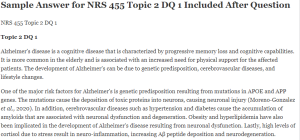NRS 455 Topic 2 DQ 1
Sample Answer for NRS 455 Topic 2 DQ 1 Included After Question
NRS 455 Topic 2 DQ 1
Topic 2 DQ 1
Alzheimer’s disease is a cognitive disease that is characterized by progressive memory loss and cognitive capabilities. It is more common in the elderly and is associated with an increased need for physical support for the affected patients. The development of Alzheimer’s can be due to genetic predisposition, cerebrovascular diseases, and lifestyle changes.
One of the major risk factors for Alzheimer’s is genetic predisposition resulting from mutations in APOE and APP genes. The mutations cause the deposition of toxic proteins into neurons, causing neuronal injury (Moreno-Gonzalez et al., 2020). In addition, cerebrovascular diseases such as hypertension and diabetes cause the accumulation of amyloids that are associated with neuronal dysfunction and degeneration. Obesity and hyperlipidemia have also been implicated in the development of Alzheimer’s disease resulting from neuronal dysfunction. Lastly, high levels of cortisol due to stress result in neuro-inflammation, increasing Aβ peptide deposition and neurodegeneration.
To prevent the development of Alzheimer’s, regular physical exercises are recommended to improve cerebral brain flow and facilitate neuroprotection. In addition, healthy diets rich in fruits, omega-3, and vegetables have been recommended to prevent the incidence of hyperlipidemia and diabetes, which are major risk factors (Yang et al., 2022). It is also important to manage chronic mental health conditions such as diabetes, hypertension, and dyslipidemia through pharmacologic and non-pharmacologic interventions to lower the incidence of Alzheimer’s. Additionally, it would be vital to provide mental stimulation for patients with a high likelihood of developing Alzheimer’s or those early in the disease to slow the rate of cognitive decline.
I would educate the family and patient diagnosed with Alzheimer’s and explain to them about the progress of the disease. I would provide a safe and supportive environment for the patient and family to promote the patient’s independence. Additionally, I would connect the family and patient to the Alzheimer’s Association, where they can get resources to help them navigate and get support (Macklin, 2021). Lastly, I would also engage the community mental health centers to support and counsel the affected patients.

References
Macklin, K. (2021). On the frontlines of the Alzheimer’s crisis: Advocacy organizations in Delaware and nationwide urge public health intervention to curb staggering disease trends. Delaware Journal of Public Health, 7(4), 20. https://doi.org/10.32481/djph.2021.09.005
Moreno-Gonzalez, I., Morales, R., Baglietto-Vargas, D., & Sanchez-Varo, R. (2020). Risk factors for alzheimer’s disease. Frontiers in Aging Neuroscience, 12, 124. https://doi.org/10.3389/fnagi.2020.00124
Yang, J. J., Keohane, L. M., Pan, X. F., Qu, R., Shu, X. O., Lipworth, L., … & Yu, D. (2022). Association of healthy lifestyles with risk of Alzheimer disease and related dementias in low-income Black and White Americans. Neurology, 99(9), e944-e953. https://doi.org/10.1212/WNL.0000000000200774

